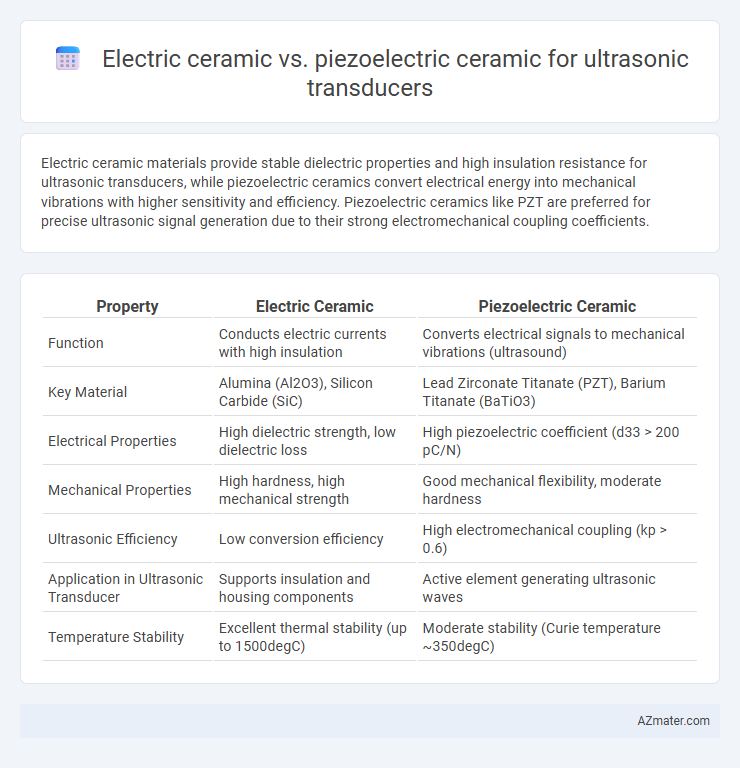Electric ceramic materials provide stable dielectric properties and high insulation resistance for ultrasonic transducers, while piezoelectric ceramics convert electrical energy into mechanical vibrations with higher sensitivity and efficiency. Piezoelectric ceramics like PZT are preferred for precise ultrasonic signal generation due to their strong electromechanical coupling coefficients.
Table of Comparison
| Property | Electric Ceramic | Piezoelectric Ceramic |
|---|---|---|
| Function | Conducts electric currents with high insulation | Converts electrical signals to mechanical vibrations (ultrasound) |
| Key Material | Alumina (Al2O3), Silicon Carbide (SiC) | Lead Zirconate Titanate (PZT), Barium Titanate (BaTiO3) |
| Electrical Properties | High dielectric strength, low dielectric loss | High piezoelectric coefficient (d33 > 200 pC/N) |
| Mechanical Properties | High hardness, high mechanical strength | Good mechanical flexibility, moderate hardness |
| Ultrasonic Efficiency | Low conversion efficiency | High electromechanical coupling (kp > 0.6) |
| Application in Ultrasonic Transducer | Supports insulation and housing components | Active element generating ultrasonic waves |
| Temperature Stability | Excellent thermal stability (up to 1500degC) | Moderate stability (Curie temperature ~350degC) |
Introduction: The Role of Ceramics in Ultrasonic Transducers
Ceramics play a crucial role in ultrasonic transducers by converting electrical energy into mechanical vibrations and vice versa, essential for precise wave generation and detection. Electric ceramics, primarily ferroelectric materials like lead zirconate titanate (PZT), exhibit strong piezoelectric properties that enable efficient ultrasonic signal transmission. Piezoelectric ceramics specifically provide high sensitivity and stability, making them ideal for high-frequency ultrasonic imaging and non-destructive testing applications.
Understanding Electric Ceramics: Properties and Applications
Electric ceramics, particularly piezoelectric ceramics such as lead zirconate titanate (PZT), exhibit unique properties that convert mechanical energy into electrical energy and vice versa, making them essential components in ultrasonic transducers. These materials possess high dielectric constants, mechanical strength, and stable piezoelectric coefficients, enabling efficient ultrasonic wave generation and reception. The choice between electric ceramic types depends on factors like frequency response, sensitivity, and durability, with piezoelectric ceramics favored for their precise energy conversion and wide application in medical imaging and industrial nondestructive testing.
Piezoelectric Ceramics: Principles and Advantages
Piezoelectric ceramics generate ultrasonic waves by converting electrical energy into mechanical vibrations through the piezoelectric effect, which involves deformation of the crystal lattice under an applied electric field. These materials, commonly lead zirconate titanate (PZT), exhibit high electromechanical coupling coefficients, enabling efficient energy conversion and precise frequency control for ultrasonic transducers. Advantages include excellent sensitivity, rapid response, and durability, making piezoelectric ceramics ideal for medical imaging, non-destructive testing, and industrial sensing applications.
Key Differences Between Electric and Piezoelectric Ceramics
Electric ceramics primarily function as insulators or conductors in ultrasonic transducers, whereas piezoelectric ceramics generate mechanical vibrations when subjected to an electric field, enabling ultrasonic wave production. Piezoelectric ceramics, such as lead zirconate titanate (PZT), exhibit high electromechanical coupling coefficients vital for efficient energy conversion, unlike non-piezoelectric electric ceramics which lack this property. The key difference lies in the direct electromechanical interaction of piezoelectric ceramics, essential for transducer performance, contrasted with the passive role of electric ceramics in the device structure.
Performance Comparison in Ultrasonic Transducer Technology
Electric ceramic and piezoelectric ceramic differ significantly in ultrasonic transducer performance, with piezoelectric ceramics exhibiting superior electromechanical coupling coefficients and higher sensitivity for efficient energy conversion. Piezoelectric ceramics enable broader frequency response and better signal-to-noise ratio, making them ideal for high-resolution ultrasonic imaging and precise thickness measurements. Electric ceramics, while simpler and more cost-effective, generally deliver lower mechanical displacement and reduced bandwidth, limiting their use in advanced ultrasonic transducer applications.
Frequency Response and Resonance Characteristics
Electric ceramic ultrasonic transducers exhibit broad frequency response and stable resonance characteristics due to their high dielectric constant and mechanical quality factor. Piezoelectric ceramics offer sharper resonance peaks and higher electromechanical coupling coefficients, enabling efficient energy conversion at specific resonant frequencies. Frequency response in piezoelectric ceramics is typically narrower but more sensitive, optimizing transducer performance for targeted ultrasonic applications.
Durability and Reliability in Ultrasonic Applications
Electric ceramic ultrasonics, primarily utilizing lead zirconate titanate (PZT), offer robust durability with stable performance under continuous high-frequency operation, making them ideal for demanding ultrasonic transducer applications. Piezoelectric ceramics demonstrate superior reliability due to their intrinsic ability to convert electrical energy to mechanical oscillations efficiently, ensuring long-term signal consistency and resistance to mechanical fatigue. Both materials excel in ultrasonic transducers, but piezoelectric ceramics typically provide enhanced longevity and operational stability in harsh or repetitive ultrasonic environments.
Cost-Effectiveness and Manufacturing Considerations
Electric ceramic for ultrasonic transducers generally offers lower material and processing costs compared to piezoelectric ceramic due to simpler composition and fabrication techniques, making it more cost-effective for large-scale production. Manufacturing piezoelectric ceramics involves complex polarization treatments and stringent quality control to achieve precise electrical-mechanical conversion efficiency, increasing production time and expenses. Selecting electric ceramic can reduce overall manufacturing costs but may result in lower performance sensitivity and bandwidth compared to piezoelectric options in advanced ultrasonic applications.
Suitability for Medical vs. Industrial Ultrasonic Transducers
Electric ceramics, primarily lead zirconate titanate (PZT), exhibit high piezoelectric coefficients, making them highly suitable for industrial ultrasonic transducers requiring robust performance and durability under harsh conditions. Piezoelectric ceramics are preferred in medical ultrasonic transducers due to their excellent sensitivity and frequency stability, which are critical for precise diagnostic imaging. The industrial applications benefit from electric ceramics' ability to operate at higher power levels, while medical devices prioritize biocompatibility and miniaturization achievable through specialized piezoelectric materials.
Future Trends: Innovations in Ceramic Materials for Ultrasonic Devices
Future trends in ultrasonic transducers emphasize advanced ceramic materials that enhance performance and energy efficiency. Developments in piezoelectric ceramics focus on nanostructured composites and lead-free alternatives to meet environmental standards and improve sensitivity. Electric ceramics are being engineered for higher dielectric constants and mechanical strength, enabling smaller, more durable ultrasonic devices with improved signal precision.

Infographic: Electric ceramic vs Piezoelectric ceramic for Ultrasonic transducer
 azmater.com
azmater.com